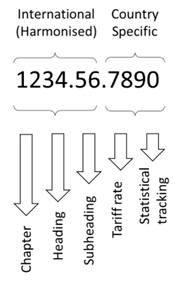How to Determine a HS Code for a Chemical
What is a HS code
A HS code is a 8 or 10 digit number from the which is given to an object when its is shipped internationally. This code loosely describes and classifies the object and is used to determine the rate of import duty and customs tariffs to be paid. A 10-digit HS code is mandatory for international trade of chemical products.
The rules for determining a HS code are governed by the World Customs Organization (WCO) to help national customs and statistical authorities classify commodities. Although “Harmonized” to the first 6 digits globally, the remaining 4 digits, along with the actual rate of duty can vary from country to country where regional customs authorities control chemical products. For instance, the Harmonized Tariff Schedule (HTS) governs the rates for chemicals imported into the US.
HS codes are also sometimes known a Commodity Codes for Chemicals, especially in Europe.

- Assigned to an object, based on its characteristics
- A HS code must be declared for any item imported/exported
- For chemicals, the HS code is mainly determined by the chemical structure and sometime properties
- The HS code is then used to determine the rate of import duty
For chemicals the HS code is mainly determined by the chemical structure and sometimes its properties or intended use.
HS Codes for chemicals
The WCO Harmonized system is divided into Chapters, often running to hundreds of pages per chapter. Chemicals and chemical products are listed in the Section VI of the Harmonized System – “Products of the Chemical or Allied Industries”. In total this consists of 11 chapters related to chemicals and chemical products (Chapter 28 to 38).
Most individual chemicals are covered by Chapter 28 (Inorganic) and Chapter 29 (Organic) chemicals, while mixtures, polymers and some use specific chemicals (e.g photographic, dyes, resins etc) are covered in specific chapters. There is also a Pharmaceutical appendix listing several thousand drugs that needs to be considered and a separate chemical appendix, which is USA specific
The full list of chapters are shown below.
- Chapter 28 Inorganic chemicals; organic or inorganic compounds of precious metals, of rare-earth metals, of radioactive elements or of isotopes
- Chapter 29 Organic chemicals
- Plus the Pharmaceutical appendix, which is should often be considered when assessing Chapter 29, especially if you know you’re likely to be shipping known drugs or medicines.
- Chapter 30 Pharmaceutical products
- Chapter 31 Fertilisers
- Chapter 32 Tanning or dyeing extracts; tannins and their derivatives; dyes, pigments and other colouring matter; paints and varnishes; putty and other mastics; inks
- Chapter 33 Essential oils and resinoids; perfumery, cosmetic or toilet preparations
- Chapter 34 Soap, organic surface-active agents, washing preparations, lubricating preparations, artificial waxes, prepared waxes, polishing or scouring preparations, candles and similar articles, modelling pastes, “dental waxes” and dental preparations with a basis of plaster
- Chapter 35 Albuminoidal substances; modified starches; glues; enzymes
- Chapter 36 Explosives; pyrotechnic products; matches; pyrophoric alloys; certain combustible preparations
- Chapter 37 Photographic or cinematographic goods
- Chapter 38 Miscellaneous chemical products
How to generate a HS Code for chemicals
Firstly, you need to find the Harmonized system (HS) in force for the country you wish to import into (note for the EU this is harmonized at the EU level). You should then identify what chapter it most belongs to, based on its “Essential character”. If for example it’s a developing fluid for photos, an explosive or a dye then choose the relevant chapter above and see if its fits within it.
US Customs and Border patrol defines this as
“the attribute which strongly marks and serves to distinguish what an article is- that which is indispensable to the structure, core, or condition of the article.”
For more general or individual chemicals its likely they will fall into chapter 28 (inorganic chemicals) or 29 (organic chemicals). These chapters focus much more on the chemical structure, classifying by chemical class and functional groups, often with specific named chemicals within a class having its own HS code.
An example from chapter 29 is below.

This unfortunately requires a chemist with good chemical knowledge.
You need to find the highest relevant and specific HS code for your chemical. As a result, its always better to start at the end of each chapter and work backwards until you find a sub heading that fits your chemical. If it first into more than 1 sub heading, use the one with the highest numerical HS code.
However please read the chapter notes at the start of each chapter and heading before starting from the end of the chapter, as they often contain very important information, clarifications and definitions.
For a chemist trained and experienced in HS coding, this typically takes 15 to 30 minutes per chemical.
Alternatively, you can use ExpediChem our HS coding system for chemicals. It will allows you to generate the correct HS code based on the chemicals structure – even if you know little about chemistry or HS codes.

Trusted by our Clients











